View in other NatureServe Network Field Guides
NatureServe
Montana
Utah
Wyoming
Idaho
Wisconsin
British Columbia
South Carolina
Yukon
California
New York
Mottled Sand Grasshopper - Spharagemon collare
General Description
The following is taken from Hebard (1928), Brooks (1958), Helfer (1971), Capinera and Sechrist (1982), Otte (1984), Vickery and Kevan (1985), Pfadt (2002), Bland (2003), Capinera et al. (2004), Brust et al. (2008), and Scott (2010). This species is a relatively large, medium brown to gray grasshopper sprinkled with dark spotting, which sometimes coalesce to form 3 or 4 indistinct bands on the tegmina (forewings). The disk of the hindwings is yellow, with a black band and short, wide spur, and wide clear tip. The median carina (ridge) of the pronotum (thorax) highly elevated and deeply cut by one sulcus (groove). The outer face of the hind femur is speckled with no bands, the inner face is yellowish with 4 black bands. The margin of the femur has a fine fringe of hair. The hind tibia is orange or red, fading toward its base.
Communicative behavior/Crepitation*
The Mottled Sand Grasshopper crepitates infrequently, mostly when disturbed. Crepitation seems insignificant as a role in courtship. This species spends much of its active time on the ground, both day and night. Males stridulate* only when they approach a female by pressing their hind femora against their forewings on both the upstroke and downstroke. Femur-tipping and femur-shaking are used in male-to-male aggression encounters, with striking the ground with its tibia tips, producing a drumming sound which can be heard several feet away (Otte 1970, 1984, and Vickery and Kevan 1985).
*Crepitation is the sound produced by grasshoppers making a clicking or snapping noise with their wings when in flight, during courtship, territorial encounters or being disturbed.
*Stridulation is rubbing one body part against another, usually the hind femur against the forewing in the case of the Band-winged Grasshoppers. This is often used for attracting a female during courtship (Otte 1970).
Phenology
The Mottled Sand Grasshopper overwinters in the egg stage. Nymphs begin to occur in the last week of May and first week of June and continue over a 23-day period. Adults are present from July to September (Otte 1984, Vickery and Kevan 1985, Pfadt 2002, Capinera et al. 2004, and Scott 2010).
Diagnostic Characteristics
The following comes from Hebard (1928), Brooks (1958), Helfer (1971), Capinera and Sechrist (1982), Otte (1984), Vickery and Kevan (1985), Pfadt (2002), Bland (2003), Capinera et al. (2004), Brust et al. (2008), and Scott (2010). The body length to end of forewings is 21-31 mm for males, and 27-37 mm for females. Wings extend 6 to 10 mm beyond the abdominal tip.
In Montana, this species can sometimes be confused with others possessing an elevated pronotal crest and deeply cut sulcus, such as
Carolina Grasshopper (
Dissosteira carolina), the two
Arphia species and those in the genus
Trimerotropis (Otte 1984, Capinera et al. 2004).
Species Range
Montana Range
Range Descriptions
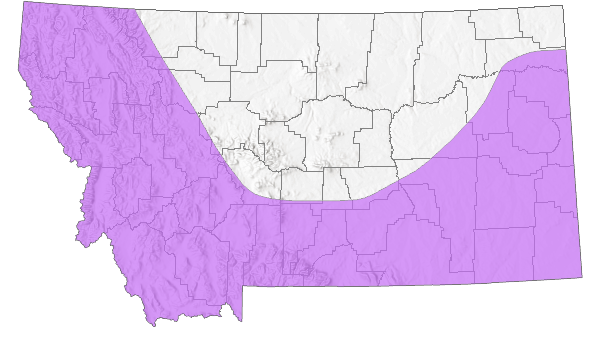
 Native
Native
Range Comments
In the west, from British Columbia to Manitoba, southward to New Mexico, Arizona, Texas, and the western Rio Grande valley of Mexico. From west to east, Idaho, and Nevada, across the Great Plains, Lake States, to New England and the upper Atlantic coast. In Montana, it has been reported for 20 counties (Otte 1984, Vickery and Kevan 1985, Pfadt 2002, Capinera et al. 2004, and Scott 2010).
Observations in Montana Natural Heritage Program Database
Number of Observations: 15
(Click on the following maps and charts to see full sized version)
Map Help and Descriptions
Relative Density
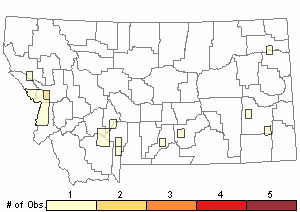
Recency
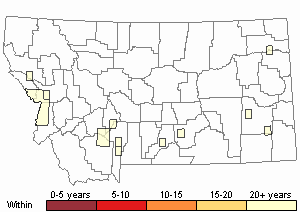
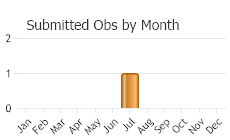
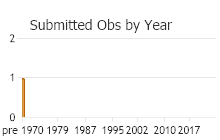
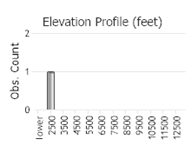 (Observations spanning multiple months or years are excluded from time charts)
(Observations spanning multiple months or years are excluded from time charts)
Habitat
This species inhabits open, sunny areas with sandy soils covered by sparse vegetation (hence its name), such as blowouts, beaches, sandy river margins, and sandy cultivated fields (Otte 1984, and Pfadt 2002).
Food Habits
The Mottled Sand Grasshopper feeds on a wide variety of grasses, sedges, and forbs. Grasses and sedges consumed in large amounts include
Blue Gramma (
Bouteloua gracilis),
Needle-and-Thread (
Stipa comata),
Western Wheatgrass (
Elymus smithii),
Sand Dropseed (
Sporobolus cryptandrus),
Witch Panicgrass (
Panicum capillare),
Thread-leaved Sedge (
Carex filifolia), and
Baltic Rush (
Juncus balticus). Favored forbs include sand sagebrush,
Flatspine Stickseed (
Lappula occidentalis), sunflowers,
Redroot Amaranth (
Amaranthus retroflexus),
Prairie Spiderwort (
Tradescantia occidentalis), lupine, and ragweed. In general, this species feeds on almost any plant species available within its preferred sandy habitats (Pfadt 2002).
Reproductive Characteristics
Males often sit motionless on bare ground for long periods of time, and then suddenly move at a rapid rate toward any other moving grasshopper—male or female, and even individuals of other species. As they approach, they make one or two pulse stridulations. If the grasshopper is a female of its species, pair formation and copulation occur. If the female is not responsive to the male’s courting, she repels him by shaking her hind femurs and striking the ground with the hind tarsi. Females oviposit their eggs in sand areas close to vegetation, requiring up to 34 minutes. Egg pods are 19.1 mm long by 4.7 mm in diameter and contain 21-28 eggs, 5 to 5.2 mm long. Hatched nymphs pass through 5 instar stages before reaching the adult stage (Pfadt 2002).
Stewardship Responsibility
References
- Literature Cited AboveLegend:
 View Online Publication
View Online Publication Bland, R.G. 2003. The Orthoptera of Michigan—Biology, Keys, and Descriptions of Grasshoppers, Katydids, and Crickets. East Lansing, MI: Michigan State University Extension, Bulletin E-2815. 221 p.
Bland, R.G. 2003. The Orthoptera of Michigan—Biology, Keys, and Descriptions of Grasshoppers, Katydids, and Crickets. East Lansing, MI: Michigan State University Extension, Bulletin E-2815. 221 p. Brooks, A.R. 1958. Acridoidea of Southern Alberta, Saskatchewan, and Manitoba (Orthoptera). The Canadian Entomologist (Supplement 9) 90:5-92.
Brooks, A.R. 1958. Acridoidea of Southern Alberta, Saskatchewan, and Manitoba (Orthoptera). The Canadian Entomologist (Supplement 9) 90:5-92. Brust, M.L, W.W. Hoback, and R.J. Wright. 2008. The Grasshoppers of Nebraska. Lincoln, NB: University of Nebraska Extension Service, APHIS.
Brust, M.L, W.W. Hoback, and R.J. Wright. 2008. The Grasshoppers of Nebraska. Lincoln, NB: University of Nebraska Extension Service, APHIS. Capinera, J.L. and T.S. Sechrist. 1982. Grasshoppers of Colorado: Identification, Biology, and Management. Fort Collins, CO: Colorado State University Experiment Station, Bulletin 584S. 161 p.
Capinera, J.L. and T.S. Sechrist. 1982. Grasshoppers of Colorado: Identification, Biology, and Management. Fort Collins, CO: Colorado State University Experiment Station, Bulletin 584S. 161 p. Capinera, J.L., R.D. Scott, and T.J. Walker. 2004. Field Guide to Grasshoppers, Katydids, and Crickets of the United States. Ithaca, NY. Cornell University Press.
Capinera, J.L., R.D. Scott, and T.J. Walker. 2004. Field Guide to Grasshoppers, Katydids, and Crickets of the United States. Ithaca, NY. Cornell University Press. Hebard, M. 1928. The Orthoptera of Montana. Proceedings of the Academy of Natural Sciences of Philadelphia, Vol. 80:211-306.
Hebard, M. 1928. The Orthoptera of Montana. Proceedings of the Academy of Natural Sciences of Philadelphia, Vol. 80:211-306. Helfer, J.R. 1971. How to Know the Grasshoppers, Crickets, Cockroaches, and Their Allies. Revised edition (out of print), Mineola, NY: Dover Publications.
Helfer, J.R. 1971. How to Know the Grasshoppers, Crickets, Cockroaches, and Their Allies. Revised edition (out of print), Mineola, NY: Dover Publications. Otte, Daniel. 1970. A comparative study of communicative behavior in grasshoppers. Miscellaneous Publications, Museum of Zoology, No. 141. Ann Arbor, MI: University of Michigan.
Otte, Daniel. 1970. A comparative study of communicative behavior in grasshoppers. Miscellaneous Publications, Museum of Zoology, No. 141. Ann Arbor, MI: University of Michigan. Otte, Daniel. 1984. The North American Grasshoppers Volume II. Acrididae (Oedipodinae). Harvard University Press. 366 pp.
Otte, Daniel. 1984. The North American Grasshoppers Volume II. Acrididae (Oedipodinae). Harvard University Press. 366 pp. Pfadt, R.E. 2002. Field Guide to Common Western Grasshoppers, 3rd edition. Laramie, WY: Wyoming Agricultural Experiment Station, Bulletin 912, modified by S. Schell and S. Schell for electronic publication. Accessed 19 February 2020. http://www.uwyo.edu/entomology/grasshoppers/field-guide/index.html#fieldguidetoc
Pfadt, R.E. 2002. Field Guide to Common Western Grasshoppers, 3rd edition. Laramie, WY: Wyoming Agricultural Experiment Station, Bulletin 912, modified by S. Schell and S. Schell for electronic publication. Accessed 19 February 2020. http://www.uwyo.edu/entomology/grasshoppers/field-guide/index.html#fieldguidetoc Scott, R.D. 2010. Montana Grasshoppers, Katydids, and Crickets A Pictorial Field Guide to the Orthoptera. MagpieMTGraphics, Billings, MT.
Scott, R.D. 2010. Montana Grasshoppers, Katydids, and Crickets A Pictorial Field Guide to the Orthoptera. MagpieMTGraphics, Billings, MT. Vickery, V. R. and D. K. M. Kevan. 1985. The grasshopper, crickets, and related insects of Canada and adjacent regions. Biosystematics Research Institute, Ottawa, Ontario. Publication Number 1777. 918 pp.
Vickery, V. R. and D. K. M. Kevan. 1985. The grasshopper, crickets, and related insects of Canada and adjacent regions. Biosystematics Research Institute, Ottawa, Ontario. Publication Number 1777. 918 pp.
- Additional ReferencesLegend:
 View Online Publication
View Online Publication
Do you know of a citation we're missing? Anderson, N.L. 1951. Field studies on the biology of range grasshoppers of southeastern Montana. M.Sc. Thesis. Bozeman, Montana: Montana State University. 96 p.
Anderson, N.L. 1951. Field studies on the biology of range grasshoppers of southeastern Montana. M.Sc. Thesis. Bozeman, Montana: Montana State University. 96 p. Anderson, N.L. 1962. Grasshopper-vegetation relationships on Montana grasslands. Ph.D Dissertation. Bozeman, Montana: Montana State University. 73 p.
Anderson, N.L. 1962. Grasshopper-vegetation relationships on Montana grasslands. Ph.D Dissertation. Bozeman, Montana: Montana State University. 73 p. Hebard, M. 1932. Notes on Montana Orthoptera. Proceedings of the Academy of Natural Sciences of Philadelphia. V. 84. pp 251-257.
Hebard, M. 1932. Notes on Montana Orthoptera. Proceedings of the Academy of Natural Sciences of Philadelphia. V. 84. pp 251-257. Kirk, K. and C.R. Bomar. 2005. Guide to the grasshoppers of Wisconsin. Madison, WI: Wisconsin Department of Natural Resources, Bureau of Integrated Science Services PUB-SS-1008. 154 p.
Kirk, K. and C.R. Bomar. 2005. Guide to the grasshoppers of Wisconsin. Madison, WI: Wisconsin Department of Natural Resources, Bureau of Integrated Science Services PUB-SS-1008. 154 p. McDaniel, B. 1987. Grasshoppers of South Dakota. Brookings, SD: South Dakota Agricultural Experiment Station, Bulletin TB 89.
McDaniel, B. 1987. Grasshoppers of South Dakota. Brookings, SD: South Dakota Agricultural Experiment Station, Bulletin TB 89. Skinner, K.F. 1995. Plant and grasshopper community composition: indicators & interactions across three spatial scales. M.Sc. Thesis. Bozeman, MT: Montana State University. 144 p.
Skinner, K.F. 1995. Plant and grasshopper community composition: indicators & interactions across three spatial scales. M.Sc. Thesis. Bozeman, MT: Montana State University. 144 p. Wachter, D.H. 1995. The ecology of selected grasshopper species along an elevational gradient. M.Sc. Thesis. Bozeman, Montana: Montana State University. 59 p.
Wachter, D.H. 1995. The ecology of selected grasshopper species along an elevational gradient. M.Sc. Thesis. Bozeman, Montana: Montana State University. 59 p.
- Web Search Engines for Articles on "Mottled Sand Grasshopper"
- Additional Sources of Information Related to "Insects"





